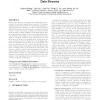246 search results - page 32 / 50 » Learning to Predict Rare Events in Event Sequences |
HPCA
2009
IEEE
14 years 8 months ago
2009
IEEE
Inductive noise forces microprocessor designers to sacrifice performance in order to ensure correct and reliable operation of their designs. The possibility of wide fluctuations i...
KDD
2006
ACM
14 years 8 months ago
2006
ACM
Mining data streams of changing class distributions is important for real-time business decision support. The stream classifier must evolve to reflect the current class distributi...
BMCBI
2007
13 years 7 months ago
2007
Background: False occurrences of functional motifs in protein sequences can be considered as random events due solely to the sequence composition of a proteome. Here we use a nume...
CAISE
2011
Springer
12 years 11 months ago
2011
Springer
Abstract. Flexibility and automatic learning are key aspects to support users in dynamic business environments such as value chains across SMEs or when organizing a large event. Pr...
IJON
2007
13 years 7 months ago
2007
We focus on how infants’ discovery of a range of affordances and effectivities contributes to participating in a new activity. We emphasize how caregivers bracket ongoing action...

